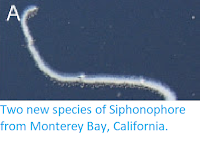The New Jersey Department of Environmental Protection has issued a warning to bathers in the Shrewsbury River in Monmouth County after researchers from Montclair State University found about 40 Clinging Jellyfish, Gonionemus vertens, during a survey of the river. These Cnidarians, which are the medusa stage of a Hydrozoan rather than a true Jellyfish, are found in Eelgrass and Seaweed beds in coastal and estuarine waters. and can produce a painful sting, mad worse by their tendency to cling to their victims and deliver repeated stings.
A Clinging Jellyfish, Gonionemus vertens. Annette Govindarajan/Woods Hole Oceanographic Institution.
Clinging Jellyfish are native to the North Pacific, where they inhabit Seagrass beds around the Russian Far East and Sea of Japan, but were introduced to the northwest Atlantic in the 1890s. They were thought to have disappeared by the 1930s as Eelgrass beds around the east coast of North America, where they had become established, died off. However, as efforts were made to restore these beds in the late twentieth century, the Jellyfish have re-appeared, and become a problem along parts of the coast between Connecticut and Maine. The Jellyfish were first observed sighted in New Jersey in 2016, and appear to be becoming established.
These 'Jellyfish' are the Medusa stage of a Olindid Hydrozoan; animals with a two-stage life history, alternating between a Jellyfish-like, free living, medusa stage, and an Anemone-like, attached polyp stage. In the case of Clinging Jellyfish the polyp is about 5 mm across, and lives on Seagrass blades or Seaweed thali. The medusa stage reaches about 2 cm across, and need to remain in the Seagrass or Algae beds where the medusae live, and have suckers with to attach to themselves, a habit that makes them particularly dangerous to bathers.
See also...
Follow Sciency Thoughts on Facebook.







